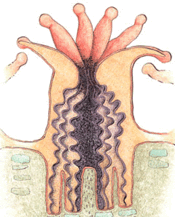Anatomy of Coral
Introduction
Visible from outer space, the Great Barrier Reef off the eastern coast of Australia is the world's largest coral reef system and the world's biggest single structure made by live organisms. If you were to move in for a closer look, you would see that the Great Barrier Reef is actually composed of thousands of smaller individual reefs. Getting closer still, you would find that each of these smaller reefs is made up of many coral heads, which themselves are made up of up to millions of tiny organisms called polyps.
You will begin this lab by examining hydra, a fresh-water relative of coral, under a microscope to observe feeding behavior and identify stinging cells that are characteristic of corals. You will also learn more about the individual animals that make up coral reefs and make a model of polyp anatomy and feeding behavior.
After completing this investigation, you should be able to:
- draw conclusions about corals by examining the behavior of hydra;
- explain and model how corals eat, grow, and reproduce; and
- explain the difference between hard and soft corals.
Keeping Track of What You Learn
Throughout these labs, you will find two kinds of questions.- Checking In questions are intended to keep you engaged and focused on key concepts and to allow you to periodically check if the material is making sense. These questions are often accompanied by hints or answers to let you know if you are on the right track.
- Stop and Think questions are intended to help your teacher assess your understanding of the key concepts and skills you should be learning from the lab activities and readings.


